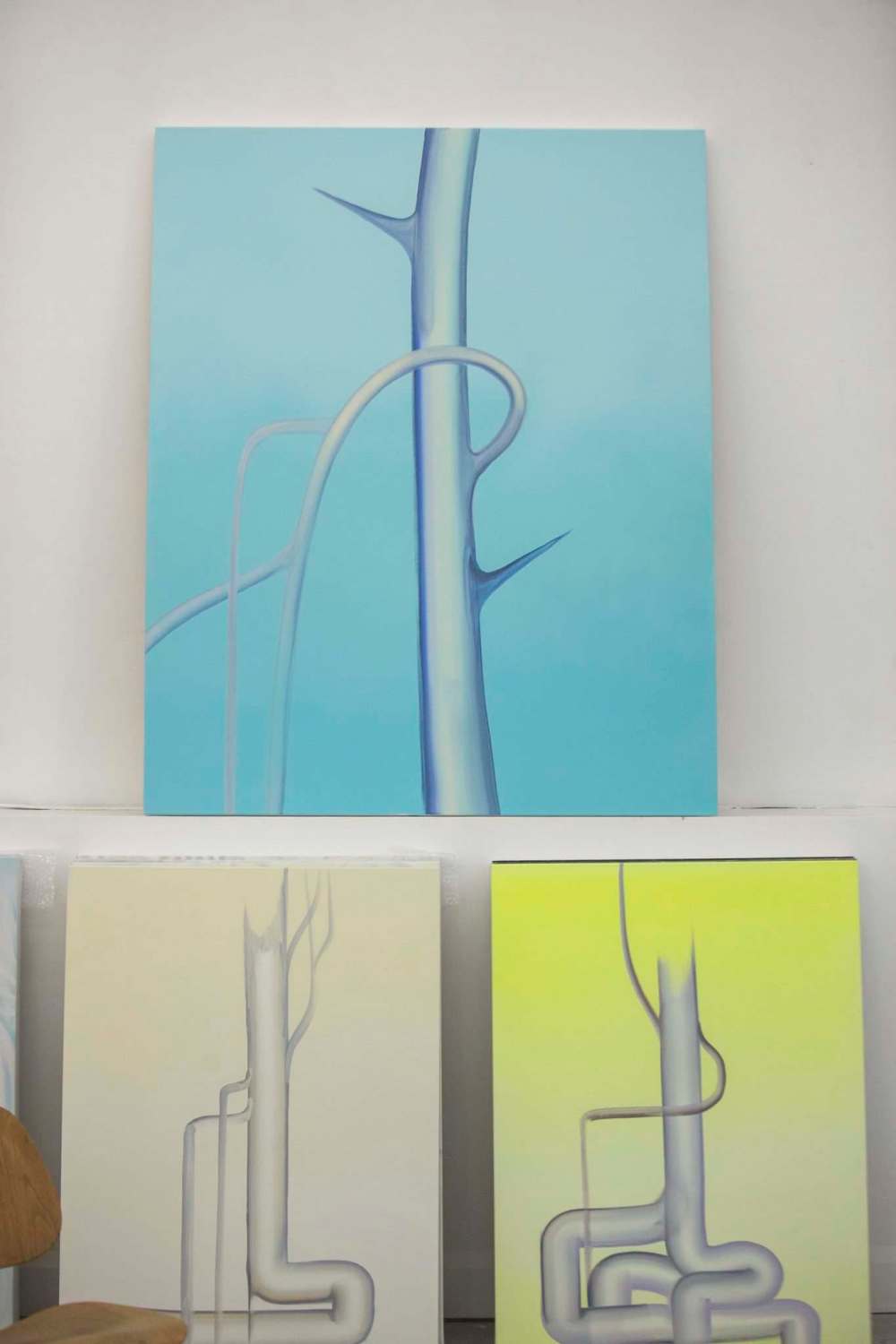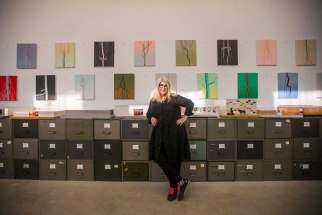The dead poplar resurrection project Retreating to her studio in the 'bush', Wanda Koop has amassed a series of paintings inspired by the forest that surrounds her there
Read this article for free:
or
Already have an account? Log in here »
To continue reading, please subscribe:
Monthly Digital Subscription
$1 per week for 24 weeks*
- Enjoy unlimited reading on winnipegfreepress.com
- Read the E-Edition, our digital replica newspaper
- Access News Break, our award-winning app
- Play interactive puzzles
*Billed as $4 plus GST every four weeks. Offer only available to new and qualified returning subscribers. Cancel any time.
Read unlimited articles for free today:
or
Already have an account? Log in here »
Hey there, time traveller!
This article was published 22/10/2021 (1229 days ago), so information in it may no longer be current.
When a tree dies, its artistic life has just begun.
That’s the way renowned Winnipeg painter Wanda Koop sees it. Dead poplars that remain standing are front-and-centre in several canvases she’s created during the COVID-19 pandemic, and they have become part of her exhibitions in 2021 and those to come in 2022.
“Seven shows planned that were cancelled. Now here we are a year later and everything is kicking in again,” Koop says. “And I’ve been in the bush for three months and now I have to strategize and figure out how I’m going to navigate everything.”

The bush is her off-the-grid cabin south of Riding Mountain National Park. A place at the lake is a refuge for so many Manitobans but for Koop, it’s her studio. While her work-from-home location is more scenic than a basement guest room, it remains her office.
She paints from 9 a.m. to 8 p.m., in the summer, taking time away from the easel to walk her dog. The dead trees, the often-overlooked remnants of the forest, become metallic-looking pipes, with branches resembling human limbs in many of her new landscapes.
“One of the things that has struck me, perhaps the most poignantly, is all the trees that die become these skeletal remains. It takes a long time for them to disappear. They become a sort of a life force of the forest in a way. Birds and animals live in them and around them,” Koop says.
“Our human skeletons get buried or disappear but this is one thing that remind us of the life cycle… that I find very touching.”

The larger finished works are perched on cabinets and lean against the wall of her Winnipeg studio, awaiting eager curators and art dealers from Canada, the United States and Europe who make the pilgrimage to the city to check out her work and include them in exhibitions or to hang on buyers’ walls.
Creating the works can be a painstaking process, but the forgotten chore for artists begins when it’s time to transport the works to galleries. Sturdy crates become as critical as paint and canvas.

“The process of getting exhibitions out the door is major, it’s huge,” Koop says. “Sometimes (curators) will come out in advance and we discuss what needs to be shipped, and then it all has to be photographed. If it’s going to the States, there’s the brokers, the trucking companies, (the paintings) have to be wrapped for shipping and insured.
“If there’s 40 or 50 paintings in an exhibition it’s a great undertaking and if there’s multiple exhibitions we’re working around the clock.”
While Koop, 70, has been considered one of Canada’s foremost painters for decades — she won the Governor General’s Award in Visual Arts in 2016 and has honorary doctorates from both the universities of Manitoba and Winnipeg — her works continue to gain acclaim and fans around the world.

Night Gallery, a Los Angeles exhibitor that represents Koop — it also hosted a solo exhibition by another Winnipeg artist, Divya Mehra, in January — was among dozens of arts organizations from around the world that took part of the annual Armory Show in New York in September.
Koop’s 2020 painting Mirror Lake — a blazing vertical yellow flash before a distant grey lakeshore — was Night Gallery’s signature painting in its online program that included six other artists from around the world.
She’s also part of its presentation at the Dallas Art Fair in November, which begins a whirlwind of Koop exhibitions that include Toronto, Brussels and Oslo in 2022.

Koop would often attend most of her shows prior to the pandemic — but she says the pandemic will likely keep her visiting only her solo exhibitions or group shows that are conveniently located.
The COVID-19 threat is one thing. Travel, once taken for granted, has become fraught with chaos.
She made it to New York to see the Armory Show in September but border delays and flight cancellations were frustrating, she says. Once she arrived though it was a positive experience to witness the City That Never Sleeps awakening.
The trip was in stark contrast to visiting Los Angeles to see an exhibition there in October 2020.
“I actually went to the opening, with COVID being less so here and it was a bit of a lull in Los Angeles,” she recalls. “It was kind of terrifying, once I got going, I thought, ‘Oh my God, what have I done, going out in the world?’ but the show went very well. And then I got here and it got really bad.”
While the pandemic has only affected the timing of her exhibitions take place and not her painting, she has noticed how it’s affected the world around her.
Like many Winnipeg artists, she lives and works in Point Douglas, one of the city’s rougher neighbourhoods. She’s lived and worked for years amid the area’s struggles with poverty and prejudice, but says the pandemic has amplified crime and the systemic problems the area has faced for years.
“We have a prowler pretty much every night, every second night,” she says. “I get so frustrated because I don’t think this needed to happen to this extreme. So now we have a huge meth problem, a housing shortage and there’s nobody minding the fort.”

She remains positive about Winnipeg though, especially architectural and artistic changes at the Winnipeg Art Gallery.
Koop pretty much grew up there, thanks to the generosity of its former head, Ferdinand Eckhardt, who she remembers placing her in children’s classes year after year until she turned 14.
Five years later, the WAG hosted her first exhibition. She was there in 1971 when Princess Margaret opened the gallery’s building and a visitor and exhibitor ever since. One of her works was part of the gallery’s award-winning 100 Masters exhibition, which marked the gallery’s 100th anniversary.
Koop founded the West Broadway organization Art City in 1998, which has encouraged many Winnipeggers, including Indigenous youth, to give art a chance.
So she’s thrilled with what the WAG has become, how Qaumajuq has so seamlessly become part of the original building and how the gallery’s exhibitions have become part of Canada’s reconciliation process, a way of closing the racial divide.
“It’s really exciting to actually see something evolve like that, something that we’ve never seen before, and it gives me hope for the future, big-picture future, and that we will be able to be one at some point in our lives.”
alan.small@freepress.mb.ca
Twitter:@AlanDSmall

Alan Small
Reporter
Alan Small has been a journalist at the Free Press for more than 22 years in a variety of roles, the latest being a reporter in the Arts and Life section.
Our newsroom depends on a growing audience of readers to power our journalism. If you are not a paid reader, please consider becoming a subscriber.
Our newsroom depends on its audience of readers to power our journalism. Thank you for your support.









